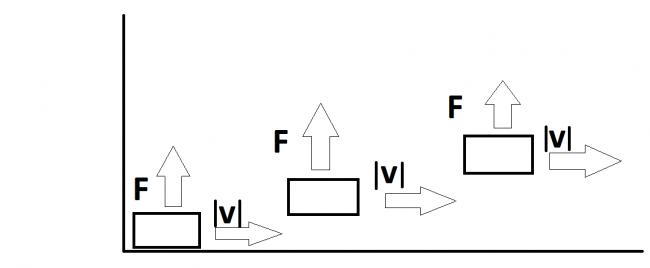The book meant the complete velocity.Use Work energy theorem,you will get the complete velocity to be constant.But,as discussed above it is not coming out to be constant.
Suppose a particle is moving along x- axis with constant velocity.A force F directed along y-axis starts acting on it.Just take the motion along y-axis of the particle.As particle accelerates along the y-direction its velocity increases along y-direction.So the net velocity has to increase.So speed increases.But why is it written in the textbooks that speed remains constant?
-
UP 0 DOWN 0 0 18

18 Answers
i thnk the book mant that |velocity| in x dirn is same...not in the y dirn...or the xy plane
As I have said that the particle is initially moving along x-direction and then a force perpendicular to it started acting on it.So it has to move along x-direction and along y-direction also.And he is not showing the complete velocity along x-direction.
in post #2 his block is getting displaced in y direction also but he shows the compelte velocity only in x direction !!!
please correct me if i m wrong
Dear EmlnEm
Arnab is showing the right diagram as I have given that a force perpendicular to it is acting on it.So it has to move towards positive y-direction.Please read the question again.And also you should read all the posts once again so that you can understand the matter properly.You will find all the answers to your question in these posts.
Thank you!
vinay u might not hav read the book properly it might hav mentioned that F is always _|_ to v
so Work done by F = 0 hence |velocity |= constant , though its direction changes
arnab ur diagram in post 2 is completely wrong how did the block move up given that u r showing its velocity always in x direction lol
 I think the speed along x-axis is taken into account............ as speed is sacaler quantity.......... As these force is acting perpendicular to the motion, it is no work force........ So, it does not affect the speed of the body...... The magnitude of velocity or the speed remains constant.......
I think the speed along x-axis is taken into account............ as speed is sacaler quantity.......... As these force is acting perpendicular to the motion, it is no work force........ So, it does not affect the speed of the body...... The magnitude of velocity or the speed remains constant.......
Yes Arnab it is right.But the book says that kinec=tic energy remains constant.But that is increasing.
but wont the speed resulting the displacement along x-axis be the same?????
the external force will result to the displacement of the body along y-axis............
Hi Arnab
Actually no force is given in the projetile motion.But according to the rules you can see speed has to increase.
in a projectile two accn. act on a body simultaeneously......g and accn. given by you......but the displacement horizontally remains unaffected by g as g acts perpendicularly to your accn.....g acts as no work force....... i think the same here also......... so, the displacement along x-axis will remain unaffected by the force so the speed will remain constant.............
this is equivalent to..
a ball being projected horizontally from top of hill...i.e. i m talking abt projectiles..
speed CANNOT remain const...:)
But as the force is along y-direction the particle has to accelerate along y-direction.So there is going to be an increase in the speed along y-direction.You have drawn three figures.In the first figure let us say that the particle is at the origin (0,0).Then in the next figure the particle is at (x,y) at time t.It has covered some distance along y-direction.The particle was at rest for the y-direction initially.But there is some displacement now.So it means that force took the particle to that point.And there must have been some speed to take it to that point.So there is going to be an increase.It can be seen from your figure also.